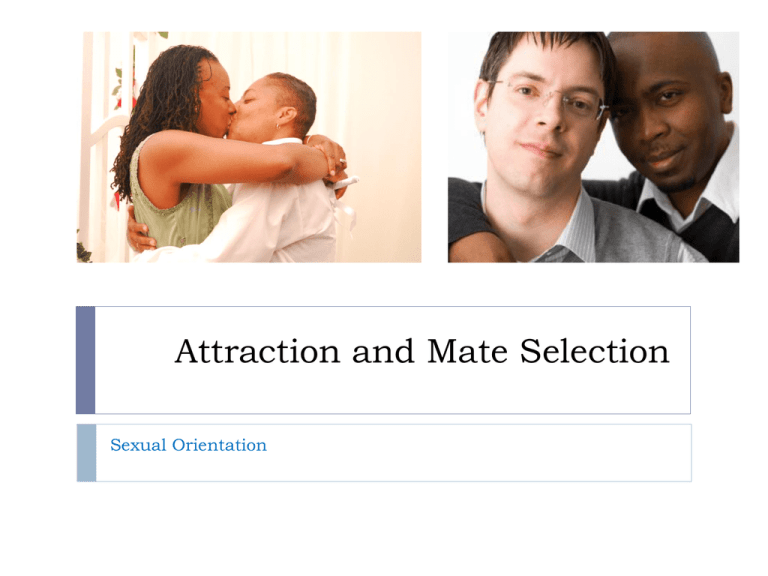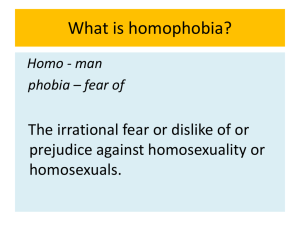Sexual Orientation
advertisement

Attraction and Mate Selection Sexual Orientation Sexual Orientation Sexual orientation - a person’s erotic and emotional orientation, toward members of his or her own gender or members of the other gender. Homosexual - a person whose sexual orientation is toward members of the same gender. Bisexual - a person whose sexual orientation is toward both men and women. Sexual Orientation Lesbian – Gay – Refers to homosexual; especially male homosexuals. Straight – Woman whose sexual orientation is toward other women. Heterosexual. LGBT – (LGBTQ = Questioning) Lesbian, Gay, Bisexual, and Transgender. Sexual Orientation Homophobia - Strong, irrational fear of homosexuals. Heterosexism - Belief that everyone is heterosexual and that heterosexuality is the norm. _______________________________________________ Many Americans express opinion that sexual relations between two adults of the same sex are always wrong (58%). 19% of women and 28% of men are victims of hate crimes because someone thought they were gay. Sexual Orientation Gay men are more educated than straight men but earn less. Receive dishonorable discharges from the armed services. Homosexuality has been grounds for firing a person from federal employment and for denial of a security clearance. Slang terms for gays and lesbians include: Queer, Fairy, Dyke, Faggot (Fag) Sexual Orientation Covert - a homosexual who is “in the closet,” who keeps his or her sexual orientation a secret. Overt - a homosexual who is “out of the closet,” who is open about his or her sexual orientation. There are varying degrees of covert and overt homosexuality. Coming Out: The process of acknowledging to oneself, and then to others, that one is gay or lesbian. Six stages of identity development: Identity confusion Identity comparison Identity tolerance Identity acceptance Identity pride Identity synthesis Sexual Orientation Gay liberation movement - has encouraged homosexuals to be more overt and to feel less guilty about their behavior. Many LGBT communities exist in neighborhoods in large cities, with bookstores, restaurants, theaters, and social organizations. International links have been cemented in the last decade. Sexual Orientation Gay bars are single bars that cater exclusively to LGBs. Gay baths - majority were closed in the 1980s, but have been resurrected in the 1990s. Sexual Orientation Families: Most children growing up in gay and lesbian families have a heterosexual orientation. Heterosexuality of parents is not essential for healthy child development. _________________________________________________________ Exclusively heterosexual - About 90 percent of men, 90 percent of women. Exclusively homosexual - About 2 percent of men, 1 percent of women. At least one same-gender sexual experience in adulthood – 10 percent of men, 10 percent of women Sexual Orientation Sexual Orientation Sin View Homosexuality used to be viewed as a sin or heresy. Medical Model The sin view has been replaced by the medical model; now viewed as a sickness or illness. Being called “sick” could be considered as another form of persecution of gays and lesbians. Sexual Orientation Conversion therapy (reparative therapy) Treatments designed to turn LGBTs into heterosexuals. American Psychiatric Association issued an official position statement opposing them. Sexual Orientation Genetic factors • 52 percent of identical twins are also gay. • 11 percent of adoptive siblings also were gay. Prenatal factors According to one theory, homosexuality is caused by a variation in prenatal development. Brain factors Scientists do not agree on whether there are significant differences between gay and straight men in the anterior region of the hypothalamus. Hormonal imbalance Attempts to cure male homosexuality by administering testosterone have failed and seem to result in even more homosexual behavior than usual. Learning Theory Evidence is mixed on this explanation of sexual orientation. Sexual Orientation Bisexuality: Men and women begin to think of themselves as bisexual in their early to mid-20s. Women are more likely to be bisexual than men. _________________________________________________________ Sexual behavior may or may not reflect identity: Deprivation homosexuality - homosexual activity that occurs in certain situations, such as prisons, when people are deprived of their regular heterosexual activity. Lesbians Until Graduation (LUGs) - women who live a lesbian lifestyle in college, then shift to heterosexuality afterward.




